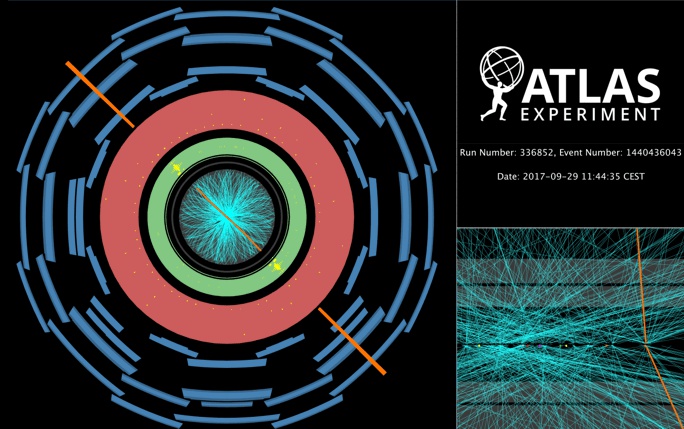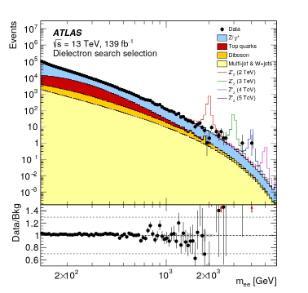High-mass dilepton searches in the ATLAS experiment

LIV.DAT student Ricardo Gonzalez Lopez is working on studies analysing the production of neutral and charged vector bosons in the ATLAS experiment, which provide a crucial benchmark to test our knowledge of the Standard Model, being well-known processes for which highly accurate theoretical predictions are available. His work has contributed to a paper by The ATLAS Collaboration, recently published in the Journal of High Energy Physics.
The Run 2 ATLAS dataset, consisting of an integrated luminosity of 139 fb-1 proton-proton collisions collected during the years 2015 and 2018 at Large Hadron Collider, provides wealth of data to explore regions of the kinematic space that had never been measured before. The high centre of mass energy reached at LHC allows to look at energies beyond the TeV frontier in the dilepton decay channel, where we can look for deviations from the Standard Model, both in the context of resonances coming from new heavy gauge bosons [1] or in the context of contact interactions [2].
While resonant searches look for anomalies based on the decays of new particles not present in the Standard Model, the non-resonant search uses a benchmark signal signature of a two-quark and two-lepton interaction which would enhance the dilepton event rate at the TeV mass range. Unfortunately, no significant deviation was found in either of the studies, although the experiment was able to produce the most stringent limits to date on Z’ masses and the energy scale of quark-lepton contact interactions.

Dilepton mass spectrum as observed by ATLAS (data points) and simulated by MonteCarlo (coloured filled distributions). New gauge boson (Z’) decays are also displayed (coloured lines). Data describes well the Standard Model expectation in masses beyond 1 TeV, showing no evidence of the presence of new heavy neutral gauge bosons (Credit: CERN).
While resonant searches look for anomalies based on the decays of new particles not present in the Standard Model, the non-resonant search uses a benchmark signal signature of a two-quark and two-lepton interaction which would enhance the dilepton event rate at the TeV mass range. Unfortunately, no significant deviation was found in either of the studies, although the experiment was able to produce the most stringent limits to date on Z’ masses and the energy scale of quark-lepton contact interactions.
In the recently published article, searching for non-resonant phenomena in the dilepton final state, Ricardo’s contribution focused on the estimation of the fake dielectron background (multijets and W+jets). This background accounts for the events coming from particles that are mis-identified by the detector as electrons, mostly consisting of jets (collimated hadron decays) and photons. Monte Carlo simulations do not offer a reliable prediction on this background so a data-driven method is used, where the estimation coming from a fake-enriched kinematic phase space is extrapolated into the signal region of the analysis.
Moving forward, the experiment pursues precision measurements of the production cross section of the dilepton final state, which will be used to test more subtle SM deviations in phenomenological interpretations such as Effective Field Theories (EFTs).
Further reading
[1] The ATLAS Collaboration., G. Aad, B. Abbott, et al. Search for high-mass dilepton resonances using 139 fb−1 of pp collision data collected at s=13 TeV with the ATLAS detector, Physics Letters B 796 (2019) 68, https://doi.org/10.1016/j.physletb.2019.07.016
[2] The ATLAS Collaboration., Aad, G., Abbott, B. et al. Search for new non-resonant phenomena in high-mass dilepton final states with the ATLAS detector. JHEP 11 (2020) 5, https://doi.org/10.1007/JHEP11(2020)005